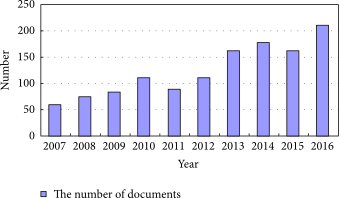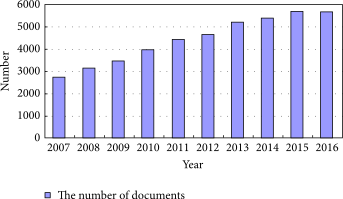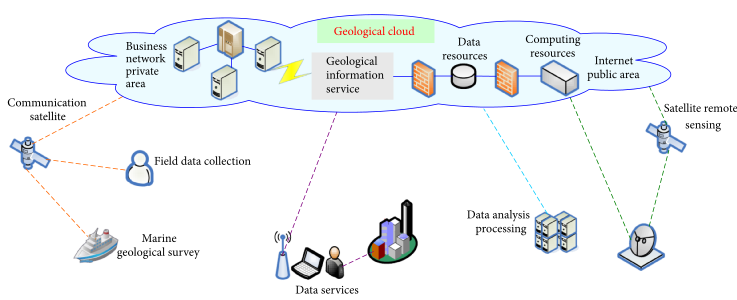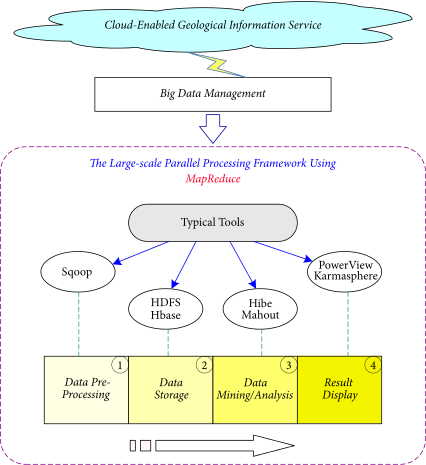Journal:Big data management for cloud-enabled geological information services
| Full article title | Big data management for cloud-enabled geological information services |
|---|---|
| Journal | Scientific Programming |
| Author(s) | Zhu, Yueqin; Tan, Yongjie; Luo, Xiong; He, Zhijie |
| Author affiliation(s) |
China Geological Survey, Ministry of Land and Resources, University of Science and Technology Beijing, Beijing Key Laboratory of Knowledge Engineering for Materials Science |
| Editors | Liu, A. |
| Year published | 2018 |
| Volume and issue | 2018(2018) |
| Page(s) | 1327214 |
| DOI | 10.1155/2018/1327214 |
| ISSN | 1875-919X |
| Distribution license | Creative Commons Attribution 4.0 International |
| Website | https://www.hindawi.com/journals/sp/2018/1327214/ |
| Download | http://downloads.hindawi.com/journals/sp/2018/1327214.pdf (PDF) |
|
|
This article should not be considered complete until this message box has been removed. This is a work in progress. |
Abstract
Cloud computing as a powerful technology of performing massive-scale and complex computing plays an important role in implementing geological information services. In the era of big data, data are being collected at an unprecedented scale. Therefore, to ensure successful data processing and analysis in cloud-enabled geological information services (CEGIS), we must address the challenging and time-demanding task of big data processing. This review starts by elaborating the system architecture and the requirements for big data management. This is followed by the analysis of the application requirements and technical challenges of big data management for CEGIS in China. This review also presents the application development opportunities and technical trends of big data management in CEGIS, including collection and preprocessing, storage and management, analysis and mining, parallel computing-based cloud platforms, and technology applications.
Introduction
In the era of big data, the data-driven modeling method enables us to exploit the potential of massive amounts of geological data easily.[1][2][3] In particular, by mining the data scientifically, one can offer new services that bring higher value to customers. Furthermore, it is now possible to implement the transition from digital geology to intelligent geology by integrating multiple systems in geological research through the use of big data and other technologies.[4]
The application of geological data management in the cloud makes it possible to fully utilize structured and unstructured data, including geology, minerals, geophysics, geochemistry, remote sensing, terrain, topography, vegetation, architecture, hydrology, disasters, and other digital geological data distributed in every place on the surface of the earth.[4][5] Moreover, the geological cloud will enable the integration of data collection, resource integration, data transmission, information extraction, and knowledge mining, which will pave the way for the transition from data to information, from information to knowledge, and from knowledge to wisdom. In addition, it supports data analysis, mining, organization, and management services for the scientific management of land resources, prospecting breakthrough strategic action and social services, while conducting multilevel, multiangle, and multiobjective demonstration applications on geological data for government decision-making, scientific research, and public services.[5]
Big data technologies are bringing unprecedented opportunities and challenges to various application areas, especially to geological information processing.[2][6][7] Under these circumstances, there are some advancements achieved in the development of this area.[8][9] Furthermore, from various disciplines of science and engineering, there has been a growing interest in this research field related to geological data generated in the geological information services (GIS). We analyzed the number of those documents indexed in the “Web of Science” research database.[10] In Figures 1 and 2, we can easily find that, in the past ten years, the number of those documents in which “geological data” is in the title and in the topic is increasing, respectively. Hence, geological data analysis in GIS is an interesting and important research topic currently.
|
|
Considering the development status of cloud-enabled geological information services (CEGIS) and the application requirements of big data management analysis, this article describes the significant impact and revolution on GIS brought by the advancement of big data technologies. Furthermore, this article outlines the future application development and technology development trend of big data management analysis in CEGIS.
The remainder of this article is organized as follows. In the next section we provide a review on CEGIS, with an emphasis on the descriptions for the system architecture and those requirements from big data management. Then, the challenges for big data management in CEGIS are presented. The key technologies and trends on big data management in CEGIS are analyzed afterwards, and finally we draw conclusions from the research.
Review on cloud-enabled geological information services
The construction of a geological cloud differs from the current big data analysis based on the internet of things (IoT). Having a deep understanding of data characteristics is necessary to collect, process, analyze, and interpret data in different fields, because the nature and types of data vary in different fields and in different problems. Geology is a data-intensive science, and geological data are characterized with multisource heterogeneity, spatiotemporal variation, correlation, uncertainty, fuzziness, and nonlinearity. Therefore, the geological cloud has a certain degree of confidentiality and it is highly domain-specific; meanwhile, it is developed on the basis of a large amount of geological data accumulated over a long period of time.[5][11] There are many real-time data generated from geological disasters and the geological environment. The geological cloud includes core basic data, which can be divided into three parts: an existing structured database, some unstructured data, and public application data. Therefore, it is important to take good advantage of the existing traditional structured data, use the big data technologies to deal with the relevant unstructured data, and also consider the peripheral public data.
Geological big data are multidimensional, and they consist of both structured and unstructured data.[12] The technical methods of big data analysis differ greatly from those of professional databases. Long-term geological survey and study have yeilded years of geological information, forming a rich and professional database, which is an important fundamental assurance for land and resources science management, geological survey, and geological information public service.[13] This “professional cloud” objectively requires technology research and development, such as the construction of a professional local area network, a data sharing platform, and geological big data visualization services. Hence, the construction of a geological cloud service is closely related to land resource management, deployment decisions, and the application demand of public service. The key technologies of research and development include the following: unstructured data extraction and mining analysis, structured and unstructured data mixed storage and management, big data sharing platform, data transmission, and visualization.[11]
Generally, the construction of a geological cloud is a long-term systematic project. This means that it is required to follow the basic principles of “standing on the reality, focusing on the future” and “focusing on the long-term and overall situation, embarking on the current and local situation,” in order to achieve the analysis and application of geological cloud public data and core data gradually in accordance with the technical route of big data analysis; thus the construction of a geological cloud will be implemented eventually. For the earth, land and resource management should cover many respects, including human behavior, climate change, development and utilization of various resources, natural disasters, environmental pollution, and the ecosystem cycle. Then the introduction of big data technologies can integrate this type of resource information to provide the ability of uniformly dealing with the problems related to the entire earth information resources, which has a significant effect on the strategic planning of land and resource management.[3]
The geological cloud is an important component of the scientific process for geological data research. The ultimate goal for developing a geological cloud is to better describe and understand the complex earth system and geological framework, provide the scientific basis for the description of the land surface and the biodiversity characteristics of the earth, and improve the ability to deal with complex social problems.
System architecture
Because the business service functions of each country differ, the system architecture of the geological cloud also will vary. In Figure 3, we present a system architecture, using China as an example.[13]
|
The geological cloud combines the geological survey intranet and the geological survey extranet. It enables the sharing and management of computing resources, storage resources, network resources, software resources, and geological data resources.[14]
The geological cloud can be summarized as having the following characteristics[13]:
(i) “One platform: The geological cloud management platform”: It uniformly manages computing resources, storage resources, network resources, software resources, and geological data resources.
(ii) “Two networks: The geological survey intranet and the geological survey extranet”: Here, the intranet is constructed by creating a network that is physically isolated from the internet. The intranet is developed on the basis of the existing geological survey network, and each node is linked through a dedicated line or bare fiber. All of the internal business management systems, software systems, and data are deployed on the internet, providing services to 28 local units and those users of more than 350 geological survey projects. Facilitated by the public geological survey network, the geological survey business management system, geological data information service system, and public geological data can be deployed on the extranet accessed by the general public. The communication between the intranet and the extranet, including data exchange and audit, can be carried out via single-directional light gate.
iii) “One main node and three domain-specific nodes”: One main node is constructed at the China Geological Survey Development Research Center. In addition, three domain-specific nodes — namely the marine node, geological environment node, and aviation geophysical exploration and remote sensing node — are constructed, respectively. Each node is configured with the corresponding servers, storage equipment, network equipment, management platform, large-scale specialized data processing software system, and various customized applications. Each node would store huge amounts of geological data and conform to current data security standards. The master node and the domain-specific nodes are linked via optical fibers. The master node will consist of 200 computing nodes with three petabytes of storage capacity and will be equipped with some geological data processing software system. The master node will be hosted in a medium-sized supercomputing center, and it will provide support for the three-dimensional seismic exploration data processing and other large-scale computing. The three domain-specific nodes are to maintain their scale in the near future to facilitate reasonable scheduling and efficient utilization of information resources and data resources.
A system for geological survey business management and auxiliary decision-making is deployed on the extranet. The system provides a real-time tracking and management function for geological survey projects and various resources.
Main users of the geological cloud include institutional users, geological survey project users, and users from the general public. The institutional users can store the current geological database and newly collected data in the geological cloud through the geological survey business network and can obtain the geological data of other institutions from the cloud as needed. The geological survey project users can access the cloud geological background data through 4G or satellite lines and can collect data through the data collection system.
Requirement from big data management
The construction of a geological cloud must meet customer demand. Big data technologies are then used as the means to implement the geological cloud.
The types and quantity of geological data have been continuously growing over the years. Geological data include all kinds of electronic documents, structured, semistructured, and unstructured data, such as various databases (map database, spatial database, and attribute database), pictures, tables, video, and audio. Generally speaking, those important data may be buried in the massive dataset without the guidance for requirements. Hence, the first step is to understand the user requirements and then gain the capability of large-scale data processing. This is followed by data mining, algorithms, and analysis, which will ultimately generate value. Big data technologies in the field of geography must meet different needs from people at different levels, including the public demand of the geologic data services and professional data demand for geological research institutions, as well as related enterprises and government departments.[15]
On the basis of big data analysis technologies, a complete data link is formed connecting data, information, knowledge, and service, through the use of an advanced cloud computing system, IoT, and big data processing flow. It is shown in Figure 4.[5]
|
References
- ↑ Vermeesch, P.; Garzenti, E. (2015). "Making geological sense of ‘Big Data’ in sedimentary provenance analysis". Chemical Geology 409: 20-27. doi:10.1016/j.chemgeo.2015.05.004.
- ↑ 2.0 2.1 Chen, J.; Xiang, J.; Hu, Q. et al. (2016). "Quantitative Geoscience and Geological Big Data Development: A Review". Acta Geologica Sinica 90 (4): 1490–1515. doi:10.1111/1755-6724.12782.
- ↑ 3.0 3.1 Zhu, Y.; Tan, Y.; Li, R. et al. (2016). "Cyber-physical-social-thinking modeling and computing for geological information service system". International Journal of Distributed Sensor Networks 12 (11). doi:10.1177/1550147716666666.
- ↑ 4.0 4.1 Kim, Y.-H.; Yarlagadda, P. (2013). "Cloud Computing Model for Big Geological Data Processing". Applied Mechanics and Materials 475–476: 306-311. doi:10.4028/www.scientific.net/AMM.475-476.306.
- ↑ 5.0 5.1 5.2 5.3 Chen, J.; Li, J.; Cui, N.; Yu, P. (2015). "The construction and application of geological cloud under the big data background". Geological Bulletin of China 34 (7): 1260–1265. http://caod.oriprobe.com/articles/46629977/The_construction_and_application_of_geological_cloud_under_the_big_dat.htm.
- ↑ Li, C. (2010). [10.1109/GEOINFORMATICS.2010.5567743 "The technical infrastructure of geological survey information grid"]. Proceedings from the 18th International Conference on Geoinformatics 2010: 1–6. 10.1109/GEOINFORMATICS.2010.5567743.
- ↑ Wu, L.; Xue, L.; Li, C. et al. (2015). "A Geospatial Information Grid Framework for Geological Survey". PLoS One 10 (12): e0145312. doi:10.1371/journal.pone.0145312.
- ↑ Evangelidis, K.; Ntouros, K.; Makridis, S.; et al. (2014). "Geospatial services in the Cloud". Computers & Geosciences 63: 116–122. doi:10.1016/j.cageo.2013.10.007.
- ↑ Huang, M.; Liu, A.; Wang, T.; Huang, C. (2017). "Green data gathering under delay differentiated services constraint for internet of things". Wireless Communications and Mobile Computing. https://www.hindawi.com/journals/wcmc/aip/9715428/.
- ↑ "Web of Science". Clarivate Analytics. https://www.webofknowledge.com/.
- ↑ 11.0 11.1 Yang, C.; Yu, M.; Hu, F. et al. (2017). "Utilizing cloud computing to address big geospatial data challenges". Computers, Environment and Urban Systems 61 (Part B): 120–128. doi:10.1016/j.compenvurbsys.2016.10.010.
- ↑ Wu, L.; Xue, L.; Li, C. et al. (2017). "A Knowledge-Driven Geospatially Enabled Framework for Geological Big Data". International Journal of Geo-Information 6 (6): 166. doi:10.3390/ijgi6060166.
- ↑ 13.0 13.1 13.2 Tan, Y. (2016). "Architecture and Key Issues of Geological Big Data and Information Service Project". Geomatics World 23 (1): 1–6. http://caod.oriprobe.com/articles/48928882/Architecture_and_Key_Issues_of_Geological_Big_Data_and_Information_Ser.htm.
Cite error: Invalid
<ref>tag; name "TanArchi16" defined multiple times with different content - ↑ He, W.; Wang, Y. (2014). "Prototype system of geological cloud computing". Progress in Geophysics 29 (6): 2886–2896. http://caod.oriprobe.com/articles/45636829/Prototype_system_of_geological_cloud_computing.htm.
- ↑ Zhu, Y.; Tan, T.; Zhang, J. et al. (2015). "A framework of hadoop based geology big data fusion and mining technologies". Cehui Xuebao/Acta Geodaetica et Cartographica Sinica 44 (S0): 152–159. doi:10.11947/j.AGCS.2015.F059.
Notes
This presentation is faithful to the original, with only a few minor changes to presentation. In some cases important information was missing from the references, and that information was added. Grammar has been updated to make the content more readable.













